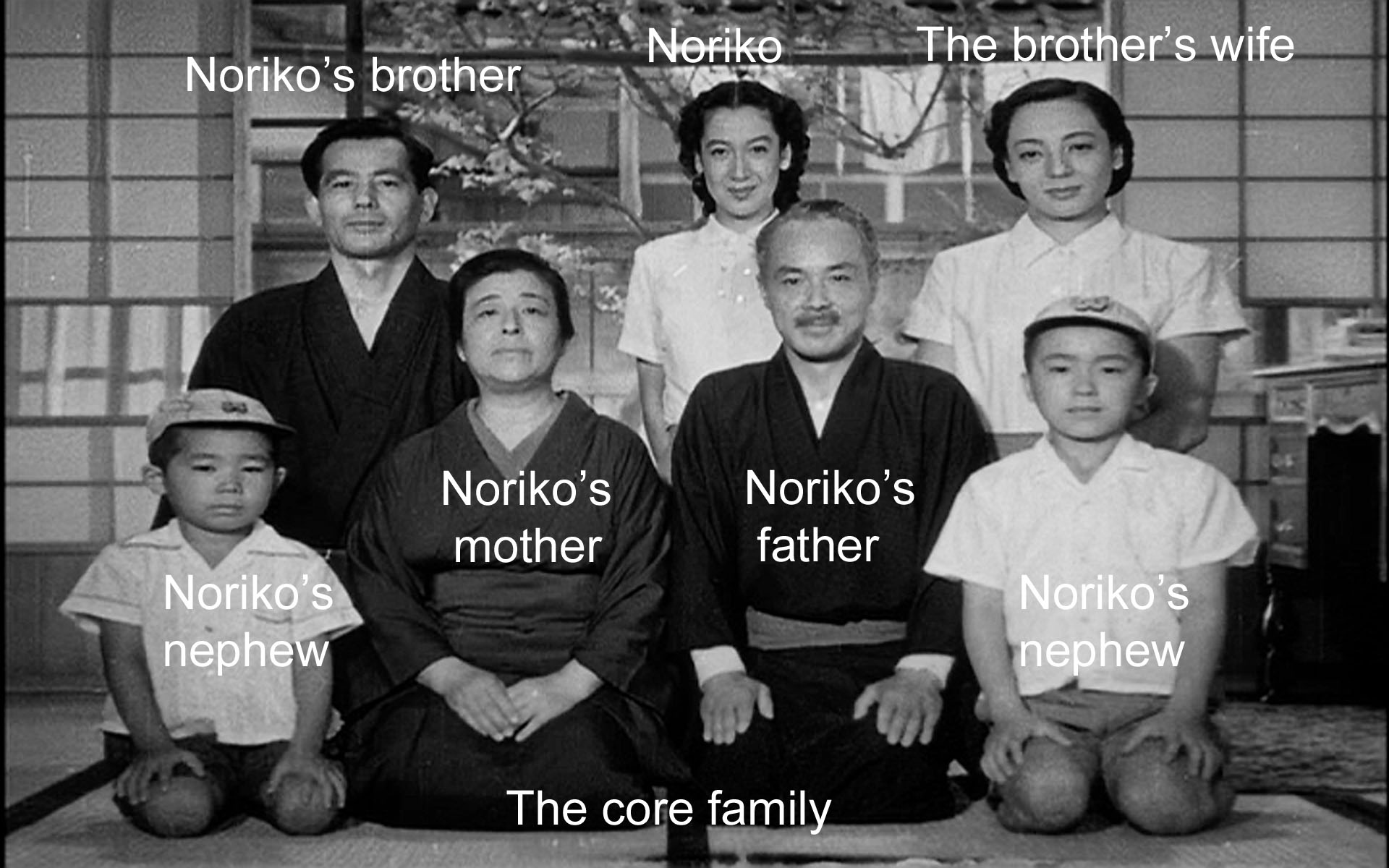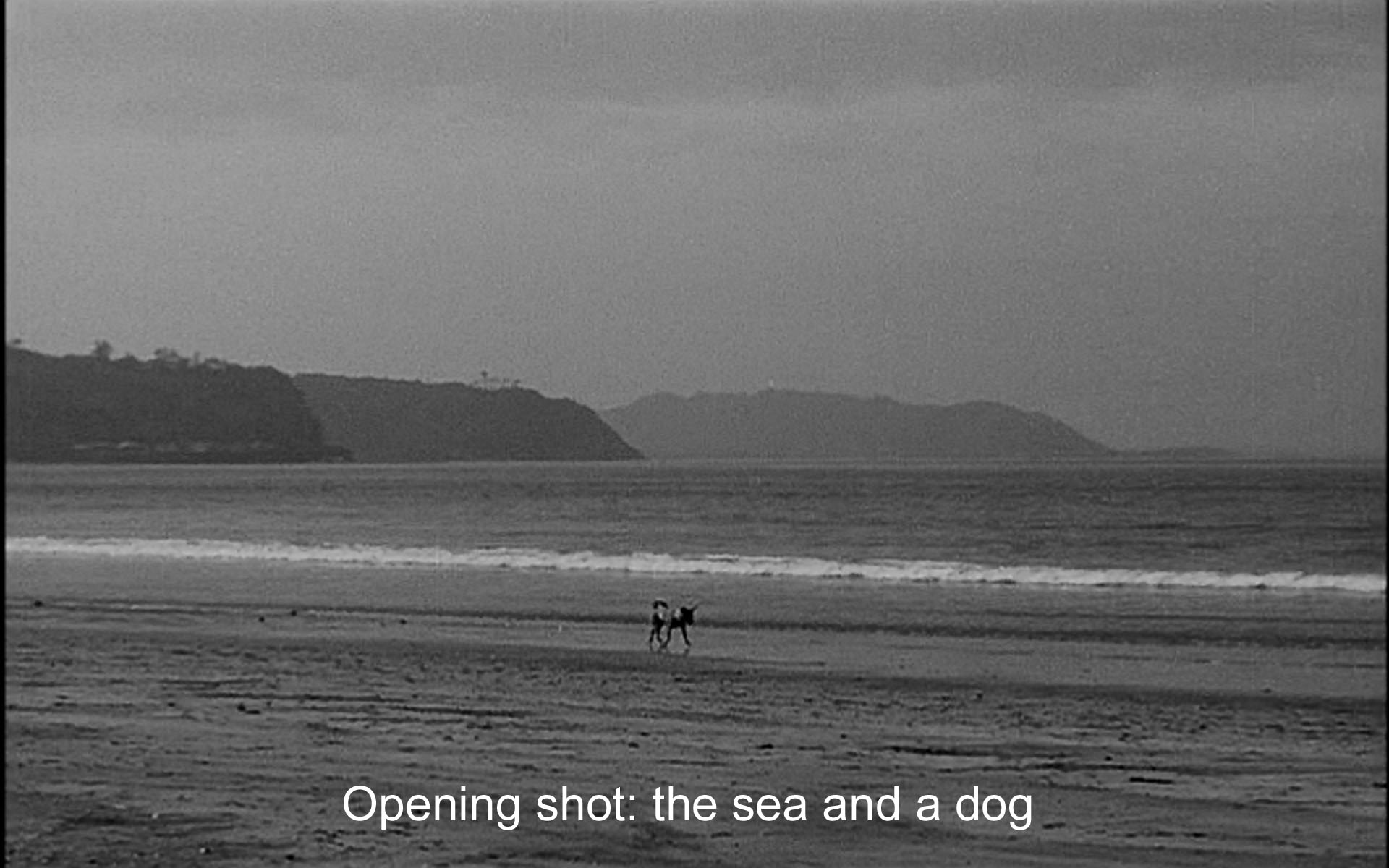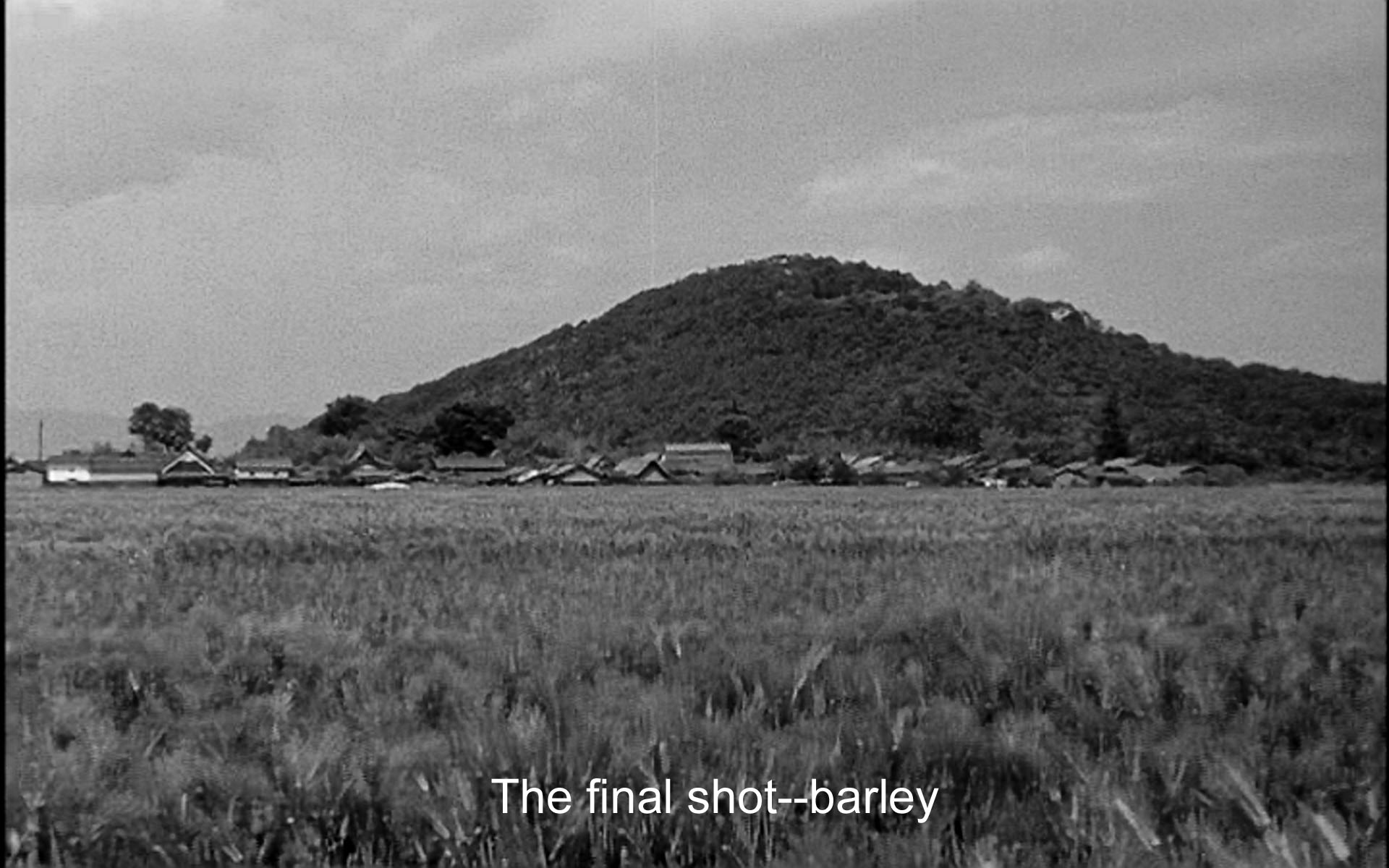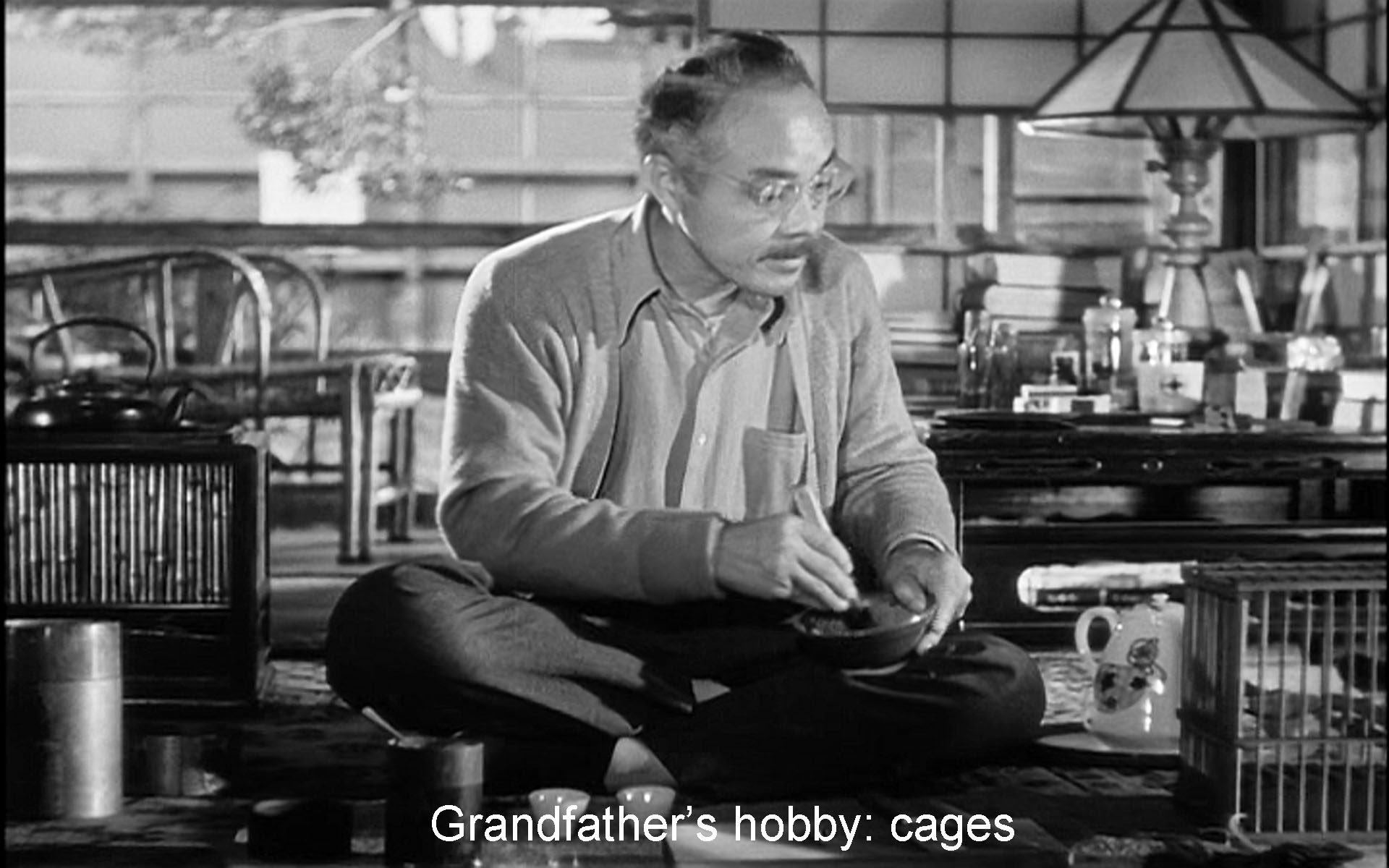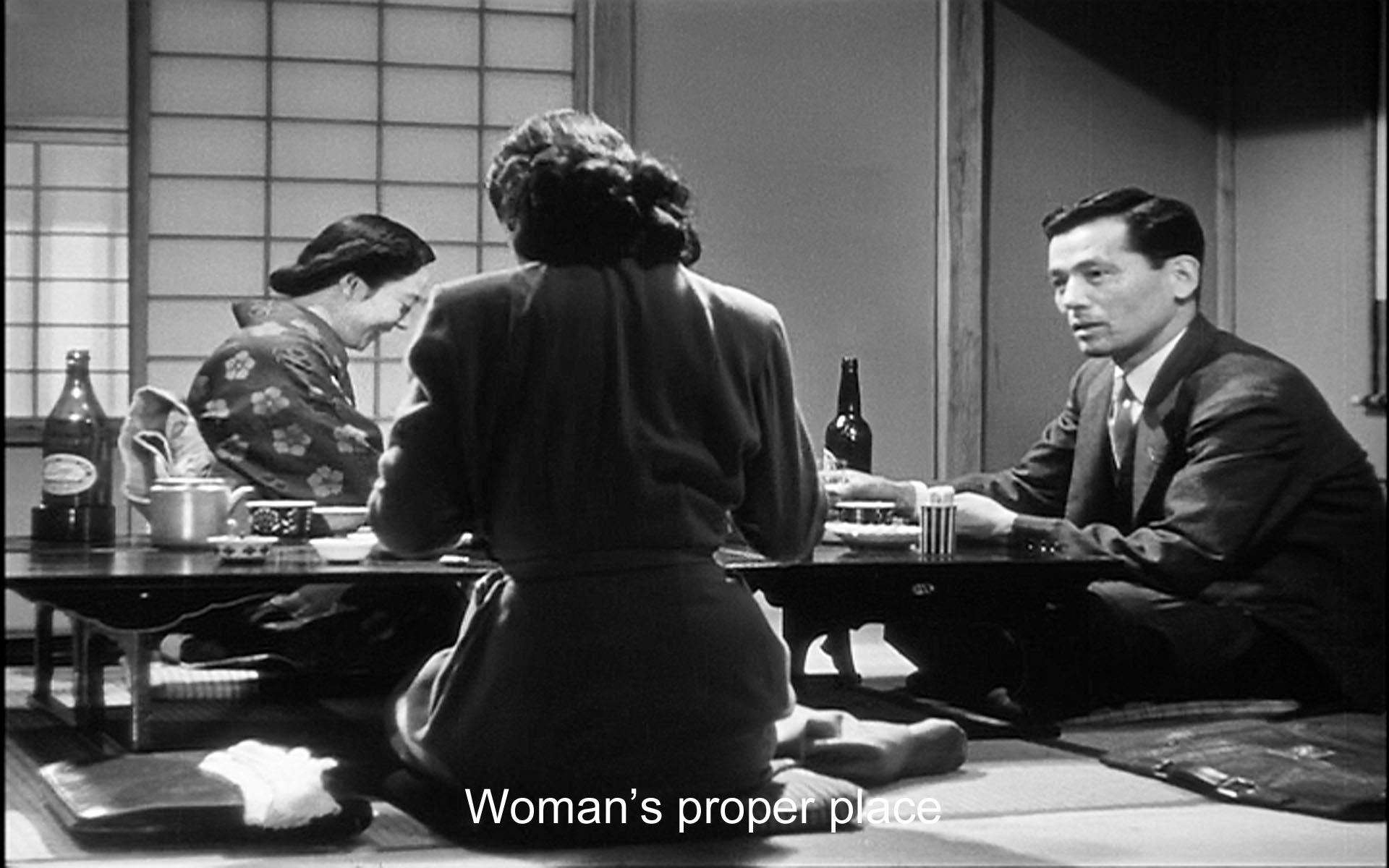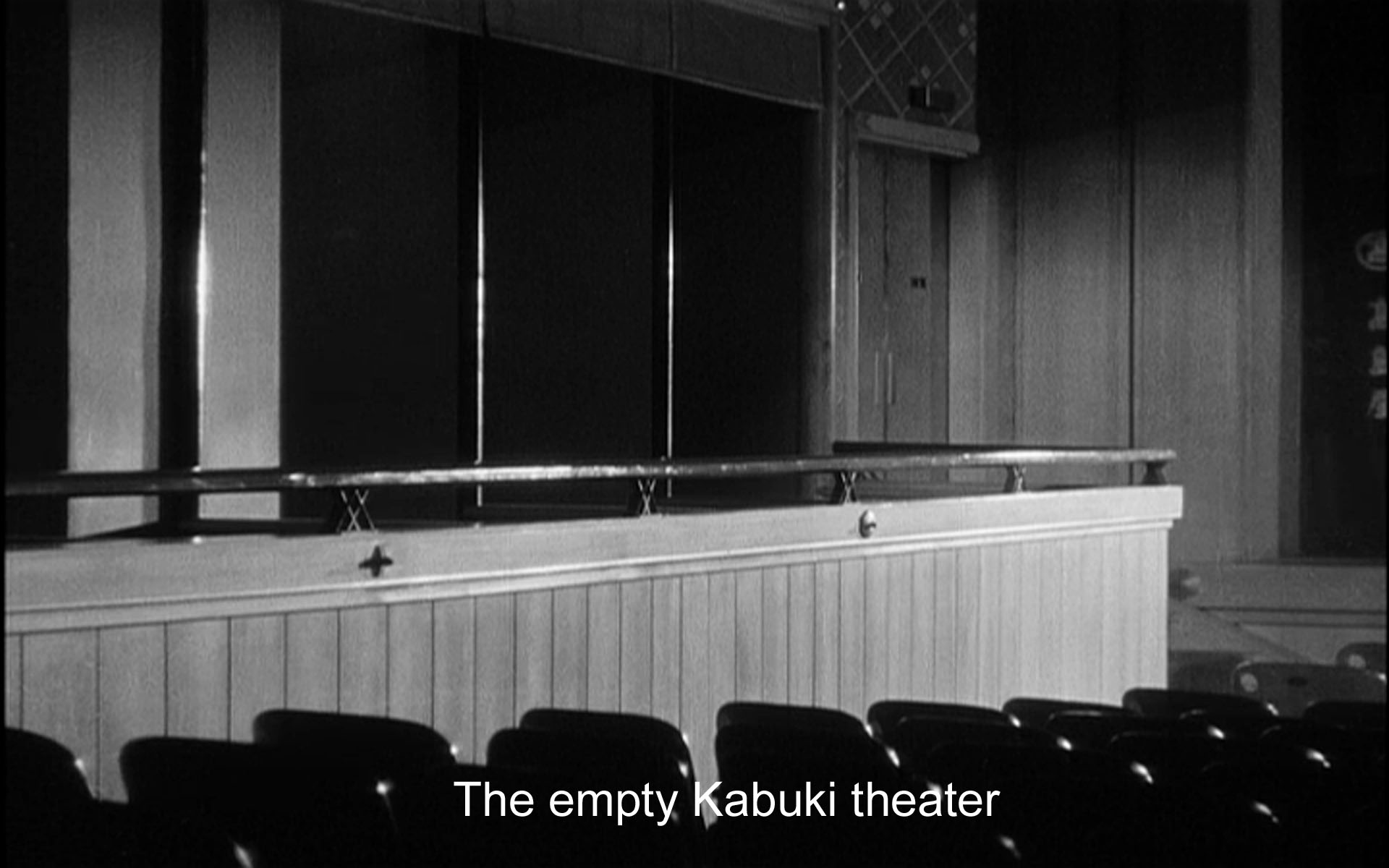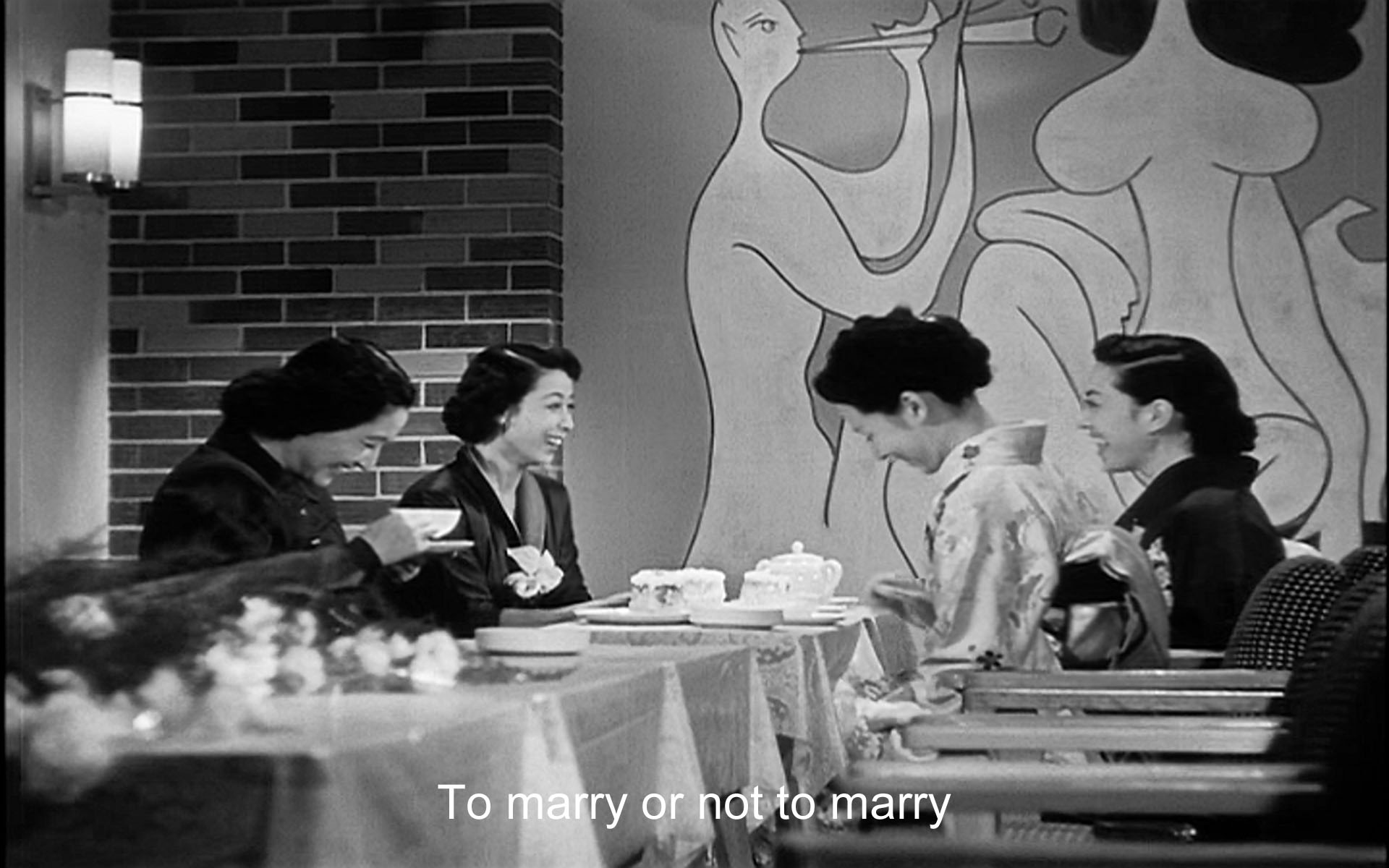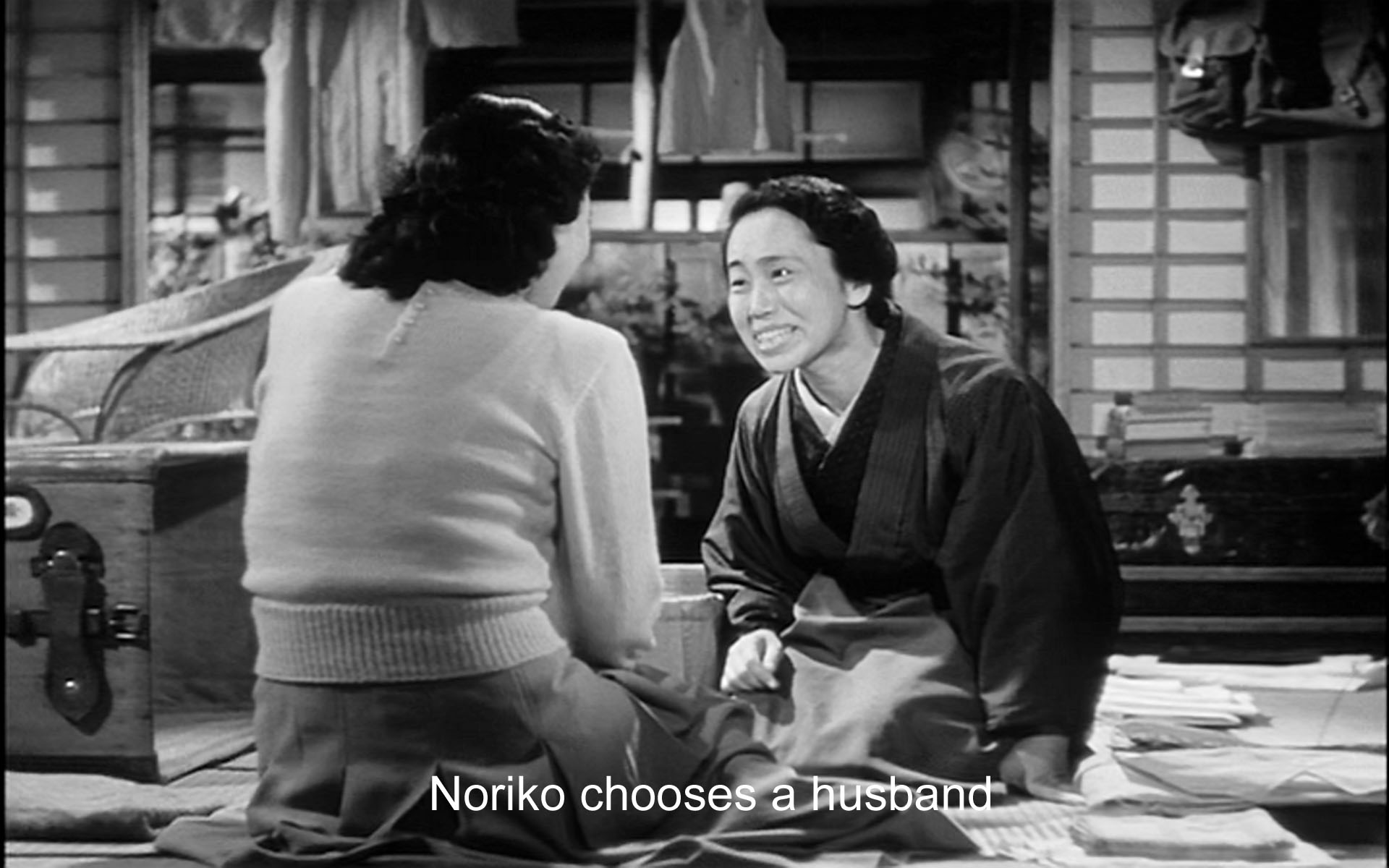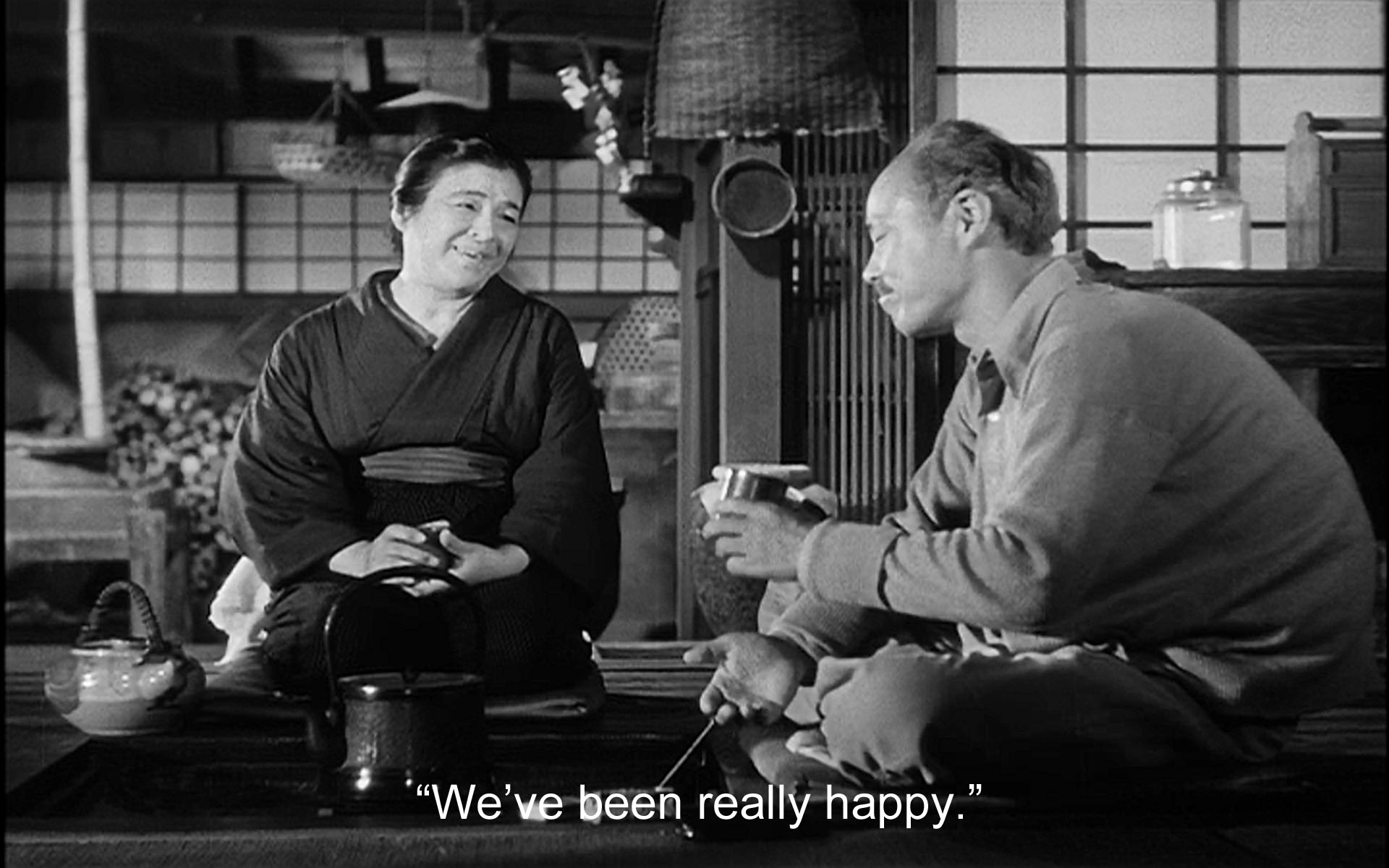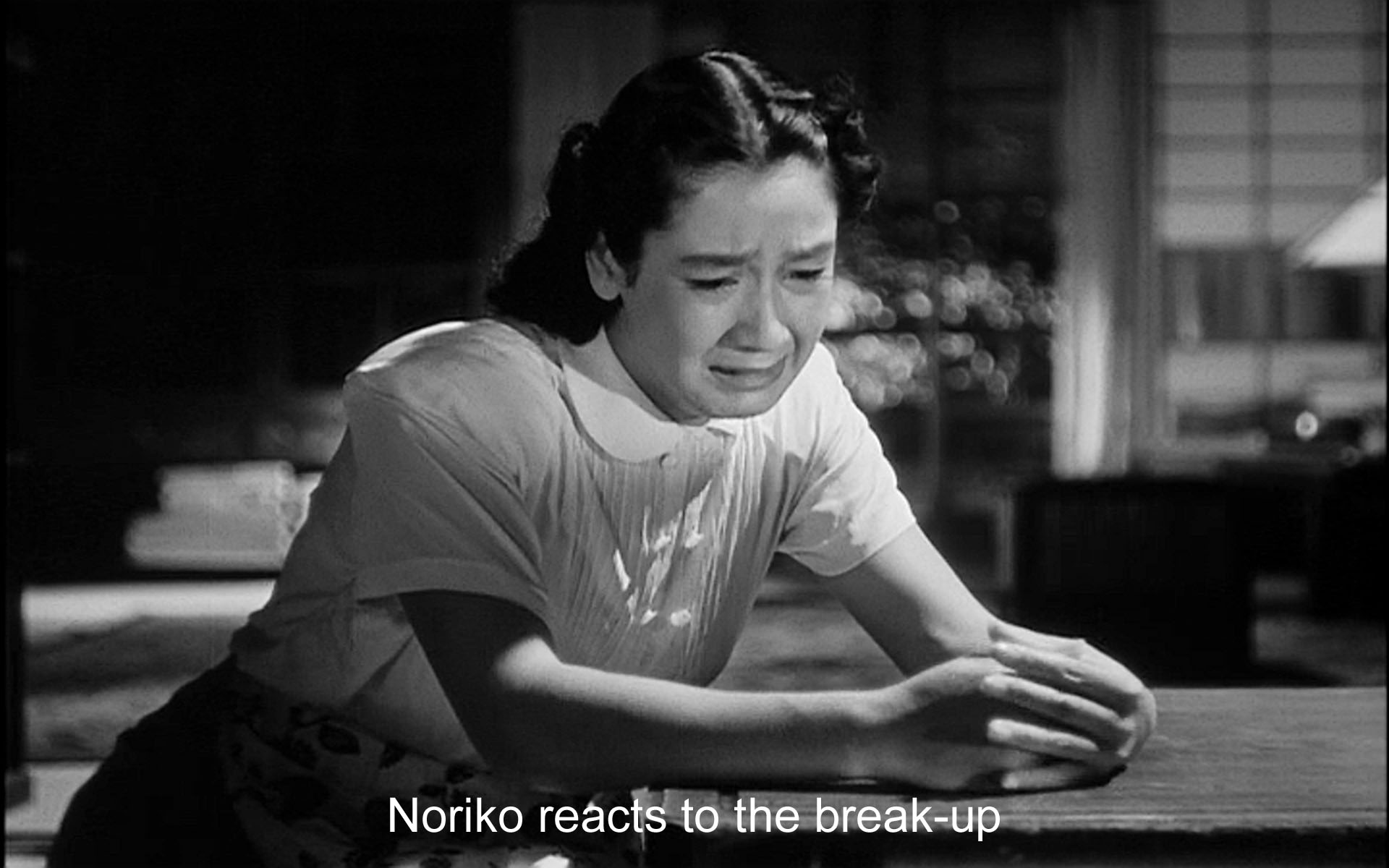Late Spring ended with a shot of the sea. Early Summer, which I think of as the anti-Late Spring, begins with a shot of the sea, but adds a dog running freely by the water’s edge. Like the opening notes of a symphony, this states (to my mind) the theme: the water represents the eternal cycles and flow of life (as in Late Spring); the dog represents freedom within those cycles. The dog represents the basic theme of the film (as I see it): possibilities, or, if you like, free will—free will within a world controlled by tradition and biology. Later, Noriko and her sister-in-law will look at the sea as they contemplate the marriage she has chosen.
Late Spring told of a daughter’s being pushed into a traditional arranged marriage. Early Summer tells of a daughter’s choosing her own husband, her rejection of her family’s arrangement, and the resulting break-up of her family. Noriko reconciles her sister-in-law Fumiko to her unarranged, freely chosen marriage as they look at the sea, echoing that first shot with its implication of freedom and choice.
Both Late Spring and Early Summer fit into a particular genre in Japanese movies, “home drama.” These films portray a conflict between the family and an individual, typically leading to the dissolution of the family. Nowadays, these don’t appear in movies so much; tv has taken them over. Both movies share elements: shortcake, the cutting of toenails, train stations, and food, food, food.
Another example of possibility is the extraordinary number of characters. This is an “ensemble picture,” that is, a film with a great number of interconnected characters, twenty-two in all. To make matters more confusing, several of the same actors in Late Spring re-appear in Early Summer, but differently. The gray-haired professor-father (Chishu Ryu) of Late Spring appears here as the black-haired older brother of Noriko, roughly her age. The pretend wife for the professor reappears as Noriko’s sister-in-law Fumiko (Kuniko Miyake). The names overlap: Mamiya for the core family, Aya for Noriko’s friend, and so on. I think Ozu is suggesting that having many possibilities is confusing. But I think he is also hinting that we humans are, no matter how many possibilities we have, much the same.
The core family appears in a farewell photograph (the first of my stills on the left). As the movie proceeds, however, others join this core group: an ancient great-uncle (who looks like a character in a Japanese print of actors’ masks) comes, bringing the number of generations in the household to four. We meet Noriko’s boss (she is a typist) and Noriko’s friend Aya (Chikage Awashima), the daughter of a restaurant owner. She comes to the office to collect for the boss’s bar bill. There is a three-way lunch in that restaurant: Noriko, her brother, and his wife in which they discuss the greater freedom of women after the war (more possibilities). There is another luncheon with Noriko and Aya and two married women, debating the merits and demerits of marriage (still more possibilities).
Food again and again provides a focal point for the discussions which are the action in this film. Food (and toenails) tie us to our basic biology, the opposite of possibility. Critic David Desser speaks of “dailiness,” Ozu’s pointing to the recurrent routines of daily life, family meals, children going off to school, parents to work, bathing, going to bed. These are the opposite of the new possibilities the film considers.
Late in the movie Noriko’s boss wonders what would have happened if he had proposed to her (more possibilities). We meet the Yabes who live next door, the mother Tami (Haruko Sugimura), her widower son, Kenkichi (Hiroshi Nihonyanagi), and his little girl. Then there are two important characters whom we never see: Shoji, a brother who never returned from World War II; Matanabe, a 40-year-old successful businessman, whom her boss suggests for Noriko and whom her family wants her to marry. All in all there are some twenty-two characters to keep track of (think of Robert Altman films like Nashville or Short Cuts).
All these characters represent possibilities, the very opposite of Ozu’s second sequence (after the sea and the dog): birds in cages (the grandfather’s hobby is making bird cages). The cages are symbolic of the closed world of family traditions. The major possibility opened up in the film is Noriko’s choosing whom she will marry herself, instead of accepting the husband planned for her (in the traditional way) by her family. The family pays a large emotional price in a sense of being rejected and a large economic price that results in the family's break-up.
It’s important to recognize, however, that this is not Romeo and Juliet. This is not a case of romantic love overruling an arranged marriage. The future groom, does not himself propose. His mother does, and he does not look entirely happy at the idea. Noriko herself speaks rather ambiguously about love. In terms of the film’s theme—possibility—what is important about this match is that Noriko accepted a possibility that suddenly opened up, a possibility outside the closed set of possibilities allowed by her family.
At its core, this film describes life as like the stock market. (One of the characters describes marriage as gambling on the horses.) Confronted with many possibilities, we humans must try to pick the one with the largest reward (of happiness) and the least risk (of misery). That is why Noriko repeatedly says of her future husband, “I can trust him.” He is a known quantity more than a loved human being—although there is a bit of that as well in this film so devoted to opening many possibilities at once. The man Noriko’s family wants her to marry is rich, but forty years old and unmarried. Noriko says, I could not trust a man who is forty and unattached.
By contrast, the man she does choose is a widower with a child, someone her family objects to and regards as risky, but she regards as safe.
Noriko’s choice leads to another “sure thing.” Her father and mother cannot live in Tokyo without her salary. Their son will continue his medical work in Tokyo, but his parents will have to go to their distant hometown, Yamato, to live with “Uncle.” Noriko will go in the opposite direction, north, to Akita, near the northernmost point on the main island of Japan. She and Aya play with the possibilities, when Aya laughingly regrets that her friend did not marry the rich man and have a refrigerator full of Coca-Cola. Noriko responds by jokily mimicking the country dialect of her new home.
Thus, Noriko’s acceptance of new possibilities means, on the one hand, the fracturing of her family (into a new start and new, but unwelcome, possibilities for the older generation). As in Late Spring, we get hints of the possibilities opened up by the westernizing influence of the American presence. And as in Ozu’s other films, he uses trains as an image for this relentless forward movement of progress (to be balanced against the more stable and comforting ways of tradition).
Here, he adds a wrinkle: the two little boys are crazy about their toy trains—a new generation indeed. One of Ozu’s surprises comes when the older boy opens a package that he thinks has the new track he has been wanting, but instead has a loaf of bread. The boy is furious and runs away (creating yet more possibilities, among them Noriko’s decision about her future husband).
The boys not only represent possibility, as any younger generation does. They themselves play with alternatives when the younger fakes washing his face or calls the old uncle names or teases his grandfather about loving him or not. And their father plays with possibilities when he plays Go, a game of territorial acquisition on a 19x19 board, a game with even more possibilities than chess. Similarly, the aged uncle enjoys a Kabuki play which simultaneously plays on the radio; then Ozu shoots the empty theater, as if to say, This place has infinite possibilities. So does Ozu's art, so restrained yet so expansive.
